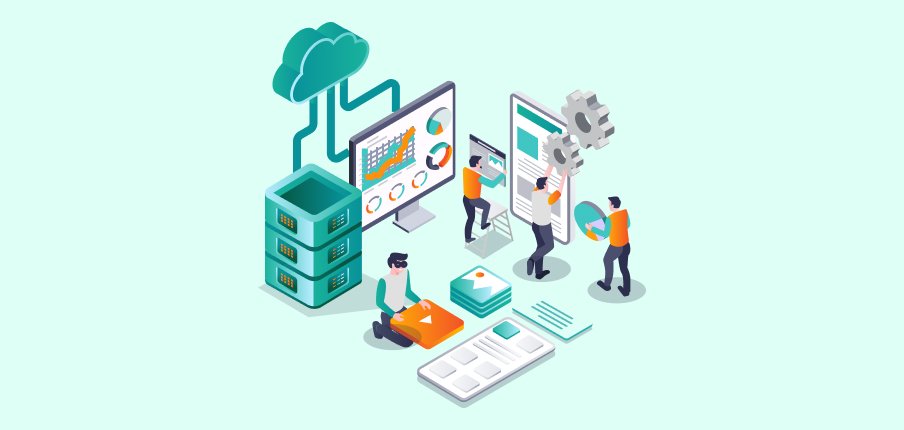
In today’s hyper-connected digital world, businesses are constantly juggling multiple applications, platforms, and data sources. From your accounting software to your customer relationship management (CRM) system and from your e-commerce platform to your marketing automation tools, each application often works in its silo. This digital separation creates inefficiencies, data inconsistencies, and a fragmented view of your business operations.
But what if these disparate systems could talk to each other, share information seamlessly, and work in perfect harmony? That’s not a far-off dream; it’s the reality made possible by API development and integration for enterprises.
APIs, or Application Programming Interfaces, are the unsung heroes of modern software. They are the invisible force that powers the connected experiences we rely on daily. Think about booking a flight online. You use an airline’s website, which pulls flight information from its systems, seat availability from another source, and payment processing from a third-party gateway, such as PayPal or Stripe.
APIs are the messengers that enable seamless data exchange. For businesses, understanding and leveraging APIs isn’t just a tech trend—it’s a fundamental strategic imperative. This blog will demystify the world of APIs, exploring what they are, how they work, and why they are the essential backbone of any modern, scalable enterprise.
What is an API? A Simple Analogy
Before we dive deep, let’s break down what an API is in simple terms. Forget the complex code and technical jargon for a moment.
Imagine you’re at a restaurant. You, the customer, want to order food from the kitchen. You don’t just walk into the kitchen and start telling the chefs what you want. Instead, you interact with a waiter. The waiter is your interface. You look at the menu (a list of available options), give your order to the waiter, who then communicates it to the kitchen, and finally brings the finished dish back to your table.
In this analogy:
- You are the user or the application trying to access data.
- The Kitchen is the server or the system where the data and functionality reside.
- The Waiter is the API.
The API (Application Programming Interface) acts as a messenger. It takes your request, translates it into a format the system (kitchen) understands, fetches the response (the food), and delivers it back to you. The API ensures that you don’t need to know the complex inner workings of the kitchen—you just need to know how to request what you want. This is the core principle of enterprise API development: creating a stable, secure API for your business’s digital services.
What is API Integration?
Now that we have discussed APIs let’s move on to the next logical question: what goes under API integration?
Simply, API integration is the process of connecting two or more software systems via their APIs, allowing them to exchange data and perform operations automatically. It will enable your software to communicate with other software, or, in more technical terms, the integration of software using APIs.
Once this link is created, you can develop new combined functionalities and optimize your business processes without having to build everything from scratch. Instead of having the marketing and sales departments manually share customer information back and forth between the CRM and the email marketing solution, the API integration enables the systems to sync in real-time, automatically.
This is a typical example of software integration via APIs. It eliminates duplicate data entry, reduces human error, and ensures that everyone within your business operates on the same data set. The primary purpose of API integration is to create a seamless digital environment where information can flow freely between your business applications, making your day-to-day operations more efficient and streamlined.
How Does API Integration Work? The Process Unpacked
It is easy to grasp the concept, but to truly understand how API integration functions in reality is to appreciate its full potential. Although the actual steps may vary depending on the project’s complexity, the underlying flow remains the same.
- Discovery and Planning: The process begins with a clear and definitive goal. What business challenge are you attempting to tackle? What information must be exchanged, and between what applications? This phase involves determining the existing APIs for the software you wish to integrate. You’ll need to review their documentation to understand their functionality, data types, and constraints. This is the first essential step in any good API integration tutorial.
- Authentication and Authorization: Security first. You can’t have any application accessing your data. APIs employ various mechanisms, such as API keys or OAuth tokens, to authenticate requests. This means that only approved applications can attach and access specific data, thereby avoiding misuse.
- Calling the API: After being authenticated, one application (the client) initiates a request with the other application’s API (the server). This request, often referred to as an “API call,” is a formatted message that indicates the operation to be executed (e.g., retrieving data with a GET request or submitting new data with a POST request) and any required parameters.
- Receiving the Response: The server processes the request, performs the action, and sends a response back to the client application. This response typically includes a status code (indicating success or failure) and the requested data, usually in a standardized format like JSON or XML.
- Data Transformation (If Required): Occasionally, the data structure of one application differs from the structure required by the other. Here, a middle layer can be used to convert the data into a suitable format before loading it into the target system.
- Testing and Deployment: Testing is not an option. Developers test the integration to verify that it’s stable, can recover from errors, and behaves well under load. After everything performs as it should, the integration is released into the production environment.
This organized API integration process guarantees that connections are secure, stable, and tailored to the distinct requirements of the business.
The Transformative Benefits of API Integration for Businesses
Why should your business invest in API development and integration? The reason lies in the deep and far-reaching advantages that have a direct impact on efficiency, innovation, and your bottom line.
- Increased Efficiency and Automation: The work is instantaneous, allowing data to be entered seamlessly between applications. Automating the data transfer between sources spares your employees from wasting countless hours of work entering data manually or shifting data across applications. They must do work deserving of their much-coveted intellectual prowess instead of spending these valuable hours copy-pasting.
- Improved Access to Data and Accuracy: Consolidation of systems forms one harmonized source of truth. Customer information modified in the CRM system is made available to the billing system and support desk, hence eliminating data silos. All departments then base their decisions on identical, correct, and current data.
- More Innovation and Flexibility: APIs enable you to introduce new features and functionality into your existing systems without requiring a complete re-engineering. This significantly accelerates the innovation process. Would you like to add a new payment method to your site? Integrate with the API of a payment service provider. This flexibility is one of the pillars of developing scalable systems using APIs.
- Enhanced Customer Experiences: Business API integration leads to improved customer experiences. Imagine a single customer portal where a user can view their order history (from your online store), check the status of their support tickets (from your ticketing system), and update their payment information (from your billing system) all in one place. APIs drive these smooth experiences.
- New Sources of Income: APIs can be products in their own right. Companies monetize their data or services by selling them to other companies through a secure API, providing entirely new sources of income.
Real-World API Integration Examples
To make the concept more concrete, let’s look at a few API integration examples that we encounter frequently:
- Social Logins: When a website or app offers the option to “Log in with Google” or “Log in with Facebook,” it utilizes API integration. The website uses the APIs provided by Google or Facebook to authenticate your identity, eliminating the need for you to store your password.
- E-commerce Checkout: When you make a purchase online and use PayPal, the e-commerce site utilizes PayPal’s API to process your payment securely. The site sends the order total to PayPal’s API, and PayPal handles the transaction, sending a confirmation back.
- Travel Aggregators: Sites like Expedia or Kayak don’t own airplanes or hotels. They utilize APIs from hundreds of airlines and hotel chains to integrate real-time pricing and availability into a single, searchable interface. This is a classic example of powerful software integration using APIs.
Why You Need a Software Development Company
Although some API integrations are straightforward, building strong, secure, and scalable connections typically requires advanced technical expertise. This is particularly so for complex enterprise API development or if you need custom API solutions built specifically for your business processes. This is where collaboration with a professional software development company in the USA can be worth its weight in gold.
A seasoned firm offers some benefits:
- Expertise: They possess a development team specializing in APIs. They’re aware of the subtleties of various API protocols, security requirements, and best practices.
- Strategy: They’ll assist you in creating an end-to-end API strategy that is aligned with your business objective, so you’re not merely linking apps but building real value.
- Efficiency: A focused team will be able to do your project much quicker and with greater reliability than an internal team that may have competing priorities.
- Maintenance and Support: API links need regular maintenance. A good partner will provide support to maintain the stability and security of your integrations as the connected applications evolve.
Whether you require assistance with API integration and development for your business or a specific custom project, an experienced partner can mean the difference between a difficult technical hurdle and business success. They offer API development and integration services that help you accomplish it correctly.
Your API Integration Guide: Key Considerations
Starting an API integration project can be overwhelming. Here are a couple of key things to remember:
- Begin with a Strategy: Don’t integrate for the sake of integrating. Clearly articulate the business issue you’re resolving and the desired result.
- Prioritize Security: Any API you use or develop must have strong security and authentication mechanisms. Data breaches cost money and erode trust.
- Scalability: As your business grows, so must your systems to continue supporting its growth. Build scalable systems with APIs that can scale to process a larger amount of data and requests.
- Select the Right Platform: Numerous tools can simplify the integration process. Consider and pick the most suitable API integration platform for your purposes, based on how easy they are to use, pre-existing connectors, and if they will scale.
- Document Everything: Good documentation is crucial when maintaining and debugging your integrations in the future.
Understanding the API Integration Cost
Lastly, let’s consider a real-world question: How much does API integration cost? The price can range widely depending on several things:
- Complexity: A straightforward one-way data sync between two leading cloud apps with good API documentation will be much less expensive than a sophisticated, real-time, two-way integration between a new SaaS platform and an old on-premises system.
- Customization: Custom API solution requirements will increase the cost, as they entail additional development effort.
- Partner You Choose: The freelance developer rates will be different from those of a top-level software development firm in the USA.
- Ongoing Maintenance: Do not overlook the cost of continuing support, monitoring, and updates.
It’s preferable to consider API integration cost not as a cost but as an investment that yields dividends in the form of enhanced efficiency, higher customer satisfaction, and enhanced business agility.
Conclusion: The Connected Future is Now
In today’s enterprise world, isolation is not an asset. Having the capacity to smoothly integrate applications, automate processes, and synchronize data in real-time is no longer an amenity—it’s the essence of a competitive, fast-moving, and customer-focused business. API creation and integration for business is the driving force behind this change.
By embracing API integration for businesses, you’re not just connecting applications; you’re building a more intelligent, responsive, and efficient organization. You’re laying the digital groundwork for innovation and growth, ensuring that your enterprise has a strong, flexible backbone capable of supporting its ambitions now and in the future. The connected future isn’t coming; it’s here, and APIs power it.






